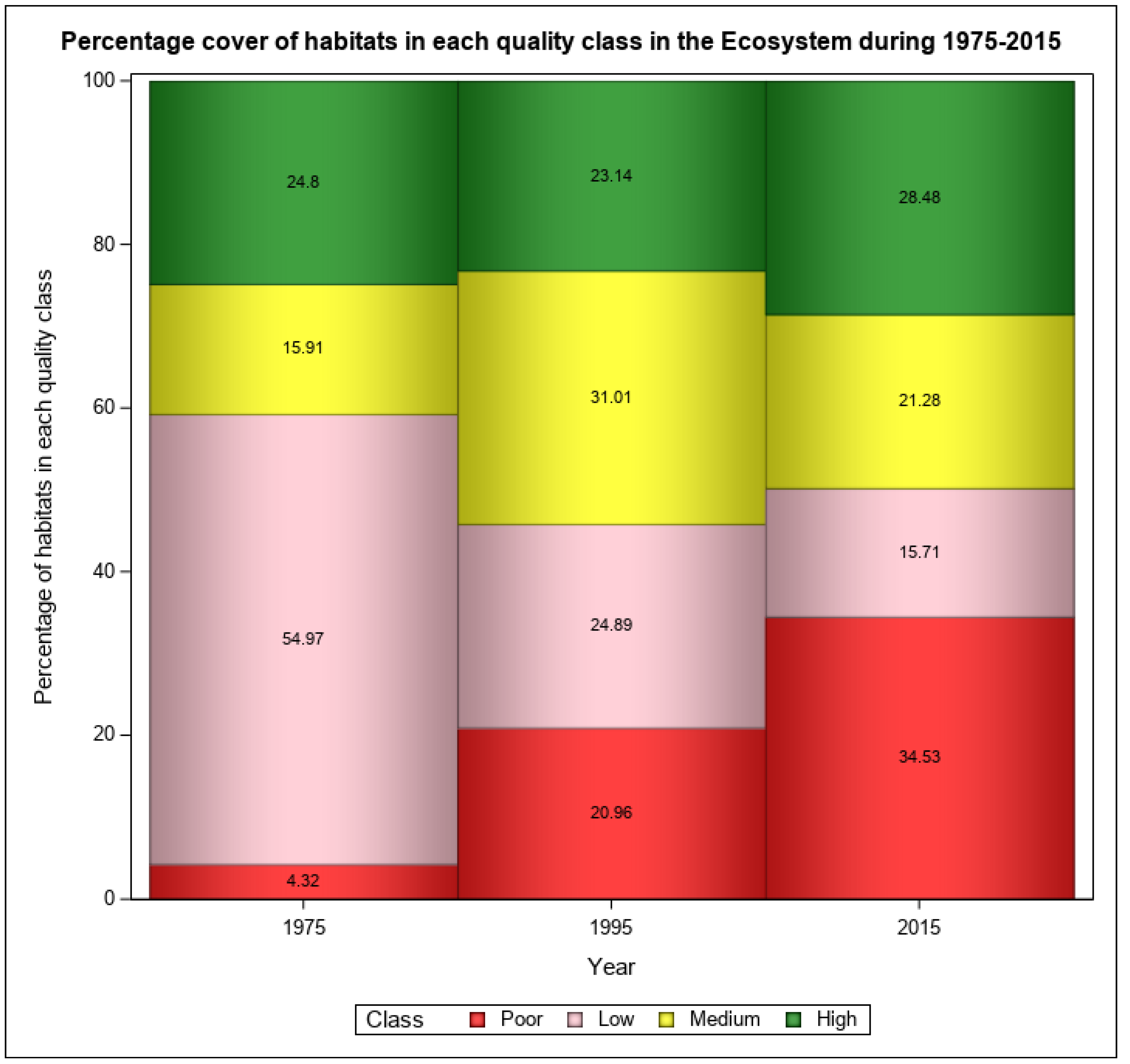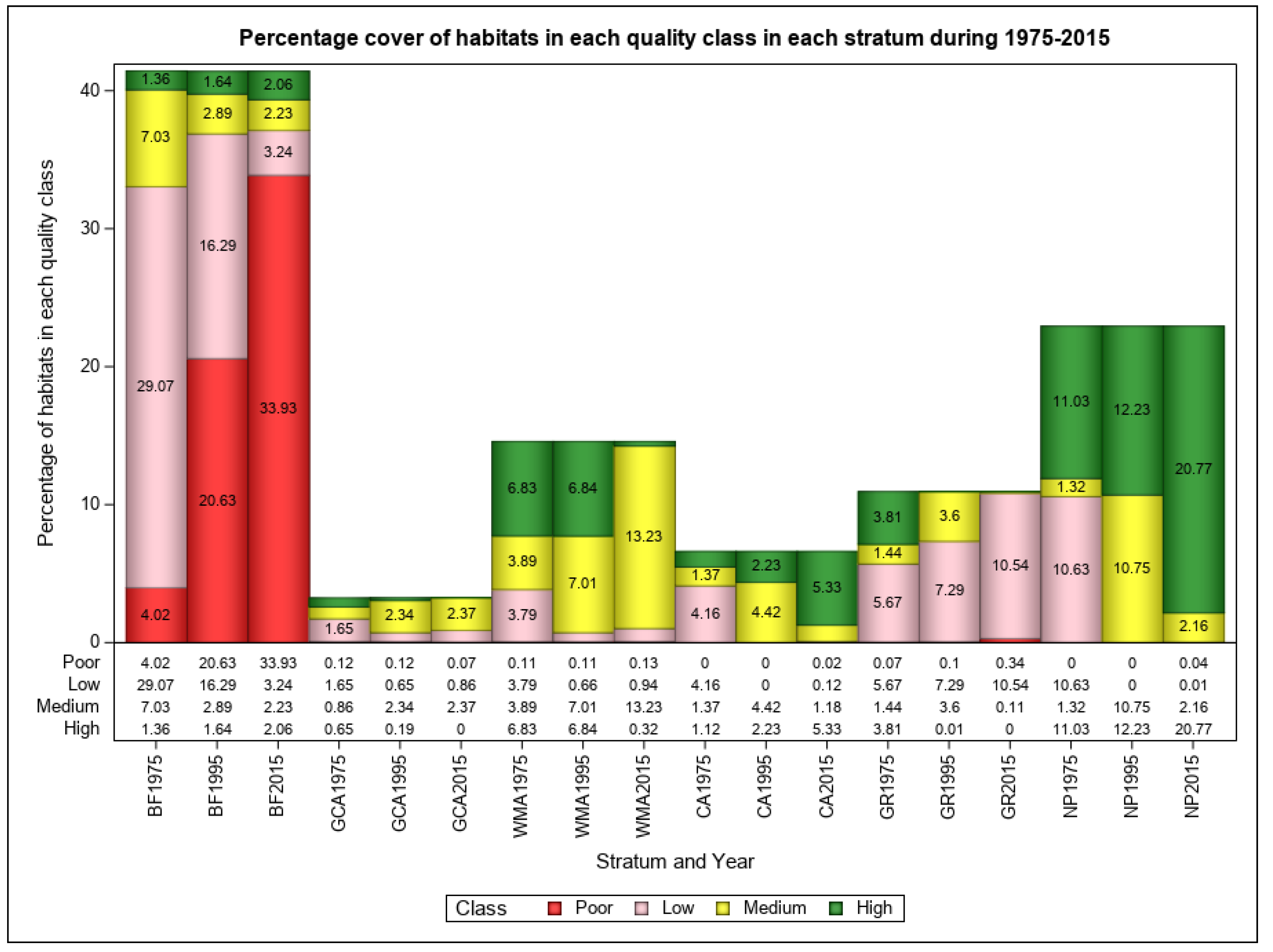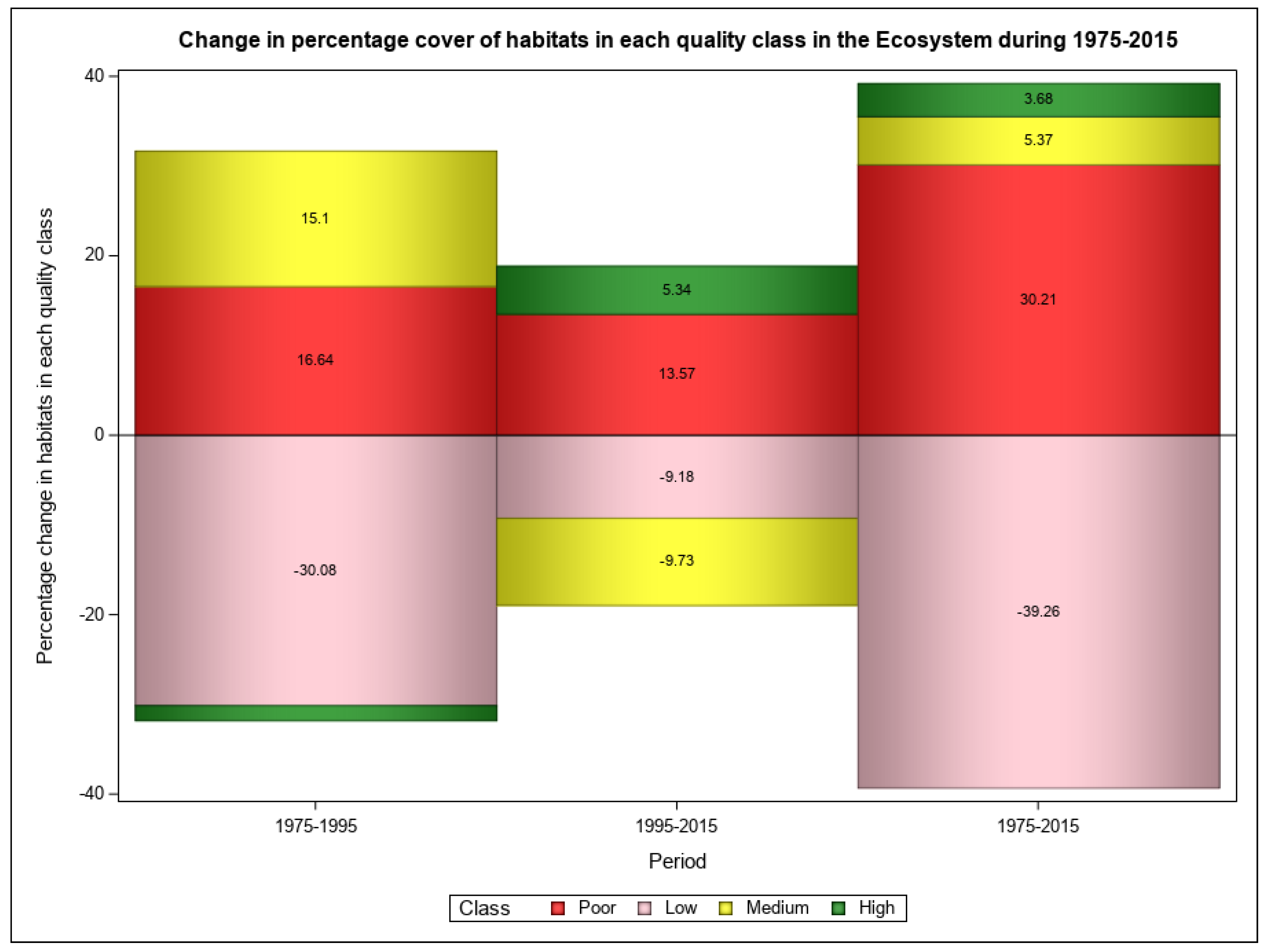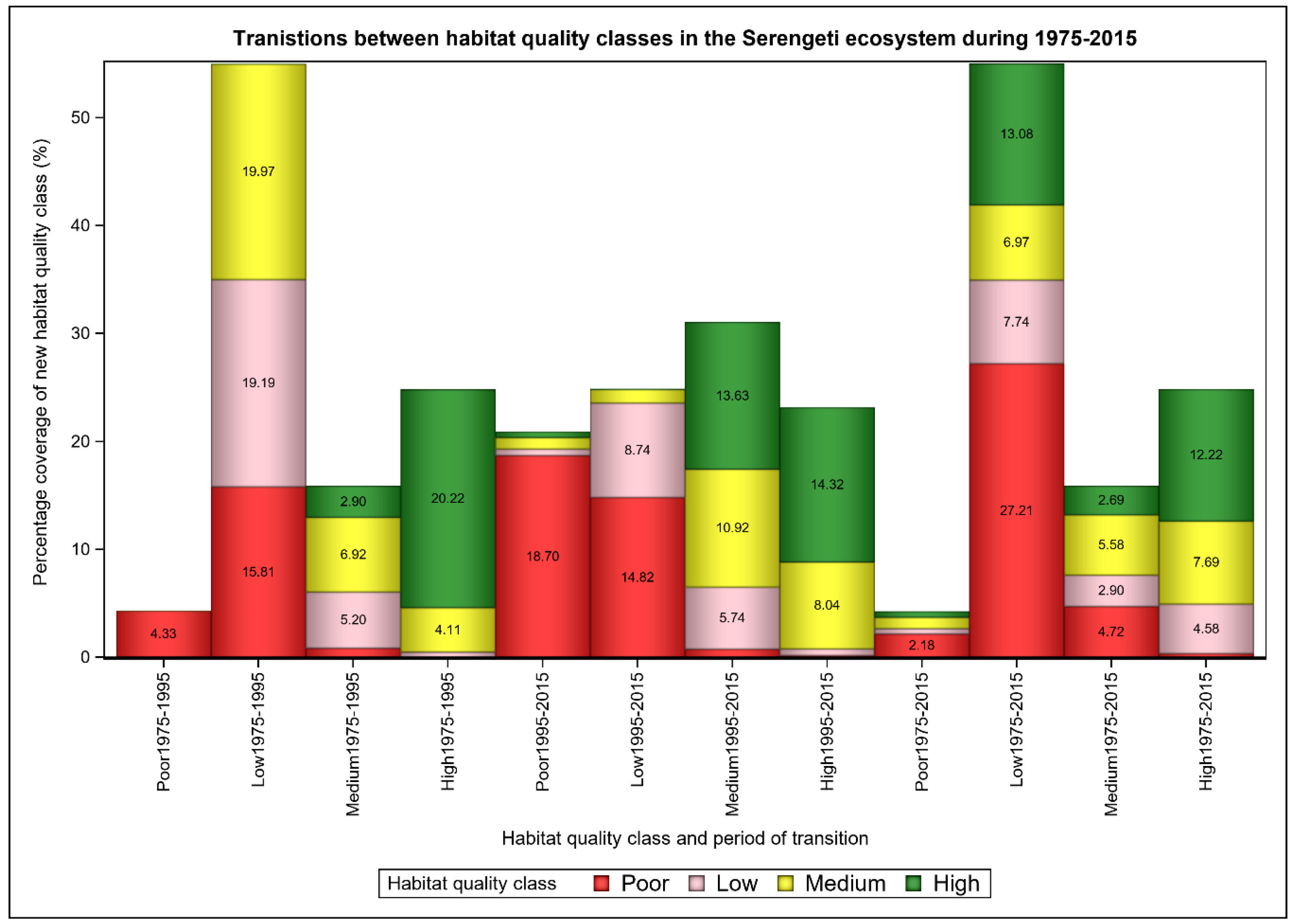Spatio-Temporal Changes in Wildlife Habitat Quality in the Greater Serengeti Ecosystem
Abstract
1. Introduction
2. Materials and Methods
2.1. Study Area
2.2. Modelling Habitat Quality Using the InVEST Model
2.3. Data Requirements and Sources
2.3.1. Land Use and Land Cover (LULC) Data
2.3.2. Habitat Threat Data
2.3.3. Legal Accessibility
2.3.4. Habitat Sensitivity
2.3.5. Half-Saturation Constant
2.4. Data Analysis
Modelling Habitat Quality Using the InVEST Model
3. Results
3.1. Habitat Quality (1975–2015)
3.2. Changes in Habitat Quality During 1975–1995, 1995–2015, 1975–2015
3.3. Transformations of Habitat Quality Classes (1975–1995, 1995–2015 and 1975–2015)
4. Discussion
Habitat Quality (1975–2015)
5. Conclusions
Author Contributions
Funding
Acknowledgments
Conflicts of Interest
References
- Davies, R.G.; Orme, C.D.; Olson, V.; Thomas, G.H.; Ross, S.G.; Ding, T.S.; Rasmussen, P.C.; Stattersfield, A.J.; Bennett, P.M.; Blackburn, T.M.; et al. Human impacts and the global distribution of extinction risk. Proc. Biol. Sci. 2006, 273, 2127–2133. [Google Scholar] [CrossRef] [PubMed]
- Zhang, H.B.; Wu, F.E.; Zhang, Y.N.; Han, S.; Liu, Y.Q. Spatial and temporal changes of habitat quality in Jiangsu Yancheng Wetland National Nature Reserve-Rare birds of China. Appl. Ecol. Environ. Res. 2019, 17, 4807–4821. [Google Scholar] [CrossRef]
- Dai, L.; Li, S.; Lewis, B.J.; Wu, J.; Yu, D.; Zhou, W.; Zhou, L.; Wu, S. The influence of land use change on the spatial–temporal variability of habitat quality between 1990 and 2010 in Northeast China. J. For. Res. 2018, 30, 2227–2236. [Google Scholar] [CrossRef]
- Terrado, M.; Sabater, S.; Acuña, V. Identifying regions vulnerable to habitat degradation under future irrigation scenarios. Environ. Res. Lett. 2016, 11, 114025. [Google Scholar] [CrossRef]
- Estes, A.B.; Kuemmerle, T.; Kushnir, H.; Radeloff, V.C.; Shugart, H.H. Land-cover change and human population trends in the greater Serengeti ecosystem from 1984–2003. Biol. Conserv. 2012, 147, 255–263. [Google Scholar] [CrossRef]
- Sharma, R.; Nehren, U.; Rahman, S.; Meyer, M.; Rimal, B.; Aria Seta, G.; Baral, H. Modeling land use and land cover changes and their effects on biodiversity in Central Kalimantan, Indonesia. Land 2018, 7, 57. [Google Scholar] [CrossRef]
- Ogutu, J.O.; Piepho, H.P.; Said, M.Y.; Ojwang, G.O.; Njino, L.W.; Kifugo, S.C.; Wargute, P.W. Extreme wildlife declines and concurrent increase in livestock numbers in Kenya: What are the causes? PLoS ONE 2016, 11, e0163249. [Google Scholar] [CrossRef]
- Kideghesho, J.R.; Nyahongo, J.W.; Hassan, S.N.; Tarimo, T.C.; Mbije, N.E. Factors and ecological impacts of wildlife habitat destruction in the Serengeti ecosystem in northern Tanzania. Afr. J. Environ. Assess. Manag. 2006, 11, 17–32. [Google Scholar]
- Sutherland, W.J. The effect of local change in habitat quality on populations of migratory species. J. Appl. Ecol. 1998, 35, 418–421. [Google Scholar] [CrossRef]
- Ryan Norris, D.; Marra, P.P. Seasonal interactions, habitat quality, and population dynamics in migratory birds. Condor 2007, 109, 535–547. [Google Scholar] [CrossRef]
- Vermeulen, C.; Huisamen, J.; Seydack, A.H. Habitat quality and the decline of an African elephant population: Implications for conservation. S. Afr. J. Wildl. Res. 24 Mon. Delayed Open Access 2000, 30, 34–42. [Google Scholar]
- Hanski, I. Habitat loss, the dynamics of biodiversity, and a perspective on conservation. Ambio 2011, 40, 248–255. [Google Scholar] [CrossRef] [PubMed]
- Carter, N.H.; Viña, A.; Hull, V.; McConnell, W.J.; Axinn, W.; Ghimire, D.; Liu, J. Coupled human and natural systems approach to wildlife research and conservation. Ecol. Soc. 2014, 19, 43. [Google Scholar] [CrossRef]
- Firbank, L.G. Striking a new balance between agricultural production and biodiversity. Ann. Appl. Biol. 2005, 146, 163–175. [Google Scholar] [CrossRef]
- Lindenmayer, D.B.; Fischer, J. Habitat Fragmentation and Landscape Change: An Ecological and Conservation Synthesis; Island Press: Washington, DC, USA, 2013. [Google Scholar]
- Boyle, T.J.; Boyle, C.E. Biodiversity, Temperate Ecosystems, and Global Change; Springer Science & Business Media: Berlin, Germany, 2013; Volume 20. [Google Scholar]
- Laurance, W.F. Habitat destruction: Death by a thousand cuts. Conserv. Biol. All 2010, 1, 73–88. [Google Scholar]
- Jackson, H.B.; Fahrig, L. Habitat loss and fragmentation. Encycl. Biodivers. 2013, 4, 50–58. [Google Scholar]
- Walelign, S.Z.; Nielsen, M.R.; Jacobsen, J.B. Roads and livelihood activity choices in the Greater Serengeti Ecosystem, Tanzania. PLoS ONE 2019, 14, e0213089. [Google Scholar] [CrossRef]
- Leblond, M.; Dussault, C.; Ouellet, J.P.; Hayssen, V. Avoidance of roads by large herbivores and its relation to disturbance intensity. J. Zool. 2013, 289, 32–40. [Google Scholar] [CrossRef]
- Johnston, C.A. Agricultural expansion: Land use shell game in the US Northern Plains. Landsc. Ecol. 2014, 29, 81–95. [Google Scholar] [CrossRef]
- Almadrones-Reyes, K.J. Predicting local habitat suitability in changing climate scenarios: Applying species distribution modelling for Diderma hemisphaericum. Curr. Res. Environ. Appl. Mycol. 2018, 8, 492–500. [Google Scholar] [CrossRef]
- McRae, B.H.; Schumaker, N.H.; McKane, R.B.; Busing, R.T.; Solomon, A.M.; Burdick, C.A. A multi-model framework for simulating wildlife population response to land-use and climate change. Ecol. Model. 2008, 219, 77–91. [Google Scholar] [CrossRef]
- Lin, Q.; Mao, J.; Wu, J.; Li, W.; Yang, J. Ecological security pattern analysis based on InVEST and least-cost path model: A case study of Dongguan water village. Sustainability 2016, 8, 172. [Google Scholar] [CrossRef]
- Bohm, T.; Hofer, H. Population numbers, density and activity patterns of servals in savannah patches of Odzala-Kokoua National Park, Republic of Congo. Afr. J. Ecol. 2018, 56, 841–849. [Google Scholar] [CrossRef]
- Sinclair, A.R.; Mduma, S.A.; Hopcraft, J.G.; Fryxell, J.M.; Hilborn, R.; Thirgood, S. Long-term ecosystem dynamics in the Serengeti: Lessons for conservation. Conserv. Biol. 2007, 21, 580–590. [Google Scholar] [CrossRef] [PubMed]
- Veldhuis, M.P.; Ritchie, M.E.; Ogutu, J.O.; Morrison, T.A.; Beale, C.M.; Estes, A.B.; Mwakilema, W.; Ojwang, G.O.; Parr, C.L.; Probert, J.; et al. Cross-boundary human impacts compromise the Serengeti-Mara ecosystem. Science 2019, 363, 1424–1428. [Google Scholar] [CrossRef] [PubMed]
- Riggio, J.; Caro, T. Structural connectivity at a national scale: Wildlife corridors in Tanzania. PLoS ONE 2017, 12, e0187407. [Google Scholar] [CrossRef] [PubMed]
- Maitima, J.M.; Mugatha, S.M.; Reid, R.S.; Gachimbi, L.N.; Majule, A.; Lyaruu, H.; Pomery, D.; Mathai, S.; Mugisha, S. The linkages between land use change, land degradation and biodiversity across East Africa. Afr. J. Environ. Sci. Technol. 2009, 3, 310–325. [Google Scholar]
- Rittenhouse, C.D.; Pidgeon, A.M.; Albright, T.P.; Culbert, P.D.; Clayton, M.K.; Flather, C.H.; Masek, J.G.; Radeloff, V.C. Land-cover change and avian diversity in the conterminous United States. Conserv. Biol. 2012, 26, 821–829. [Google Scholar] [CrossRef]
- Díaz, S.; Settele, J.; Brondízio, E.; Ngo, H.; Guèze, M.; Agard, J.; Arneth, A.; Balvanera, P.; Brauman, K.; Butchart, S. Summary for Policymakers of the Global Assessment Report on Biodiversity and Ecosystem Services of the Intergovernmental Science-Policy Platform on Biodiversity and Ecosystem Services; IPBES: Paris, France, 2019. [Google Scholar]
- Gaston, K.J.; Jackson, S.F.; Cantú-Salazar, L.; Cruz-Piñón, G. The ecological performance of protected areas. Annu. Rev. Ecol. Evol. Syst. 2008, 39, 93–113. [Google Scholar] [CrossRef]
- Hamilton, C.M.; Martinuzzi, S.; Plantinga, A.J.; Radeloff, V.C.; Lewis, D.J.; Thogmartin, W.E.; Heglund, P.J.; Pidgeon, A.M. Current and future land use around a nationwide protected area network. PLoS ONE 2013, 8, e55737. [Google Scholar] [CrossRef]
- Hansen, A.J.; DeFries, R.S.; Turner, W. Land use change and biodiversity. In Land Change Science; Springer: Berlin, Germany, 2012; pp. 277–299. [Google Scholar]
- Mosser, A.; Fryxell, J.M.; Eberly, L.; Packer, C. Serengeti real estate: Density vs. fitness-based indicators of lion habitat quality. Ecol. Lett. 2009, 12, 1050–1060. [Google Scholar] [CrossRef] [PubMed]
- Hopcraft, J.G.C.; Holdo, R.; Mwangomo, E.; Mduma, S.; Thirgood, S.; Borner, M.; Fryxell, J.; Olff, H.; Sinclair, A. Why are wildebeest the most abundant herbivore in the Serengeti ecosystem. In Serengeti IV: Sustaining Biodiversity in a Coupled Human-Natural System; University of Chicago Press: Chicago, IL, USA, 2015; pp. 35–71. [Google Scholar]
- Kennedy, A.S.; Kennedy, V. Animals of the Serengeti: And Ngorongoro Conservation Area; WILDGuides: Princeton, NJ, USA, 2014. [Google Scholar]
- Holdo, R.M.; Fryxell, J.M.; Sinclair, A.R.; Dobson, A.; Holt, R.D. Predicted impact of barriers to migration on the Serengeti wildebeest population. PLoS ONE 2011, 6, e16370. [Google Scholar] [CrossRef] [PubMed]
- Thirgood, S.; Mosser, A.; Tham, S.; Hopcraft, G.; Mwangomo, E.; Mlengeya, T.; Kilewo, M.; Fryxell, J.; Sinclair, A.R.E.; Borner, M. Can parks protect migratory ungulates? The case of the Serengeti wildebeest. Anim. Conserv. 2004, 7, 113–120. [Google Scholar] [CrossRef]
- Bai, Y.; Zhuang, C.; Ouyang, Z.; Zheng, H.; Jiang, B. Spatial characteristics between biodiversity and ecosystem services in a human-dominated watershed. Ecol. Complex. 2011, 8, 177–183. [Google Scholar] [CrossRef]
- Leh, M.D.K.; Matlock, M.D.; Cummings, E.C.; Nalley, L.L. Quantifying and mapping multiple ecosystem services change in West Africa. Agric. Ecosyst. Environ. 2013, 165, 6–18. [Google Scholar] [CrossRef]
- Haiping, L.; Yanan, Q.; Yunying, Q. Use a spatial analysis model to assess habitat quality in Lashihai watershed. J. Resour. Ecol. 2018, 9, 622–631. [Google Scholar] [CrossRef]
- Sallustio, L.; De Toni, A.; Strollo, A.; Di Febbraro, M.; Gissi, E.; Casella, L.; Geneletti, D.; Munafo, M.; Vizzarri, M.; Marchetti, M. Assessing habitat quality in relation to the spatial distribution of protected areas in Italy. J. Environ. Manag. 2017, 201, 129–137. [Google Scholar] [CrossRef]
- Duarte, G.T.; Ribeiro, M.C.; Paglia, A.P. Ecosystem services modeling as a tool for defining priority areas for conservation. PLoS ONE 2016, 11, e0154573. [Google Scholar] [CrossRef]
- Baral, H.; Keenan, R.J.; Sharma, S.K.; Stork, N.E.; Kasel, S. Spatial assessment and mapping of biodiversity and conservation priorities in a heavily modified and fragmented production landscape in north-central Victoria, Australia. Ecol. Indic. 2014, 36, 552–562. [Google Scholar] [CrossRef]
- Reed, D.N.; Anderson, T.M.; Dempewolf, J.; Metzger, K.; Serneels, S. The spatial distribution of vegetation types in the Serengeti ecosystem: The influence of rainfall and topographic relief on vegetation patch characteristics. J. Biogeogr. 2009, 36, 770–782. [Google Scholar] [CrossRef]
- Cutler, D.R.; Edwards, T.C., Jr.; Beard, K.H.; Cutler, A.; Hess, K.T.; Gibson, J.; Lawler, J.J. Random forests for classification in ecology. Ecology 2007, 88, 2783–2792. [Google Scholar] [CrossRef] [PubMed]
- Sharp, R.; Tallis, H.; Ricketts, T.; Guerry, A.; Wood, S.; Chaplin-Kramer, R.; Nelson, E.; Ennaanay, D.; Wolny, S.; Olwero, N. InVEST User’s Guide; The Natural Capital Project; Stanford University: Stanford, CA, USA, 2014. [Google Scholar]
- Bukombe, J.; Kittle, A.; Senzota, R.B.; Kija, H.; Mduma, S.; Fryxell, J.M.; Magige, F.; Mligo, C.; Sinclair, A.R.E. The influence of food availability, quality and body size on patch selection of coexisting grazer ungulates in western Serengeti National Park. Wildl. Res. 2019, 46, 54–63. [Google Scholar] [CrossRef]
- Eigenbrod, F.; Hecnar, S.J.; Fahrig, L. Accessible habitat: An improved measure of the effects of habitat loss and roads on wildlife populations. Landsc. Ecol. 2008, 23, 159–168. [Google Scholar] [CrossRef]
- Cardinale, B.J.; Duffy, J.E.; Gonzalez, A.; Hooper, D.U.; Perrings, C.; Venail, P.; Narwani, A.; Mace, G.M.; Tilman, D.; Wardle, D.A.; et al. Biodiversity loss and its impact on humanity. Nature 2012, 486, 59–67. [Google Scholar] [CrossRef]
- Said, M.Y.; Ogutu, J.O.; Kifugo, S.C.; Makui, O.; Reid, R.S.; De Leeuw, J. Effects of extreme land fragmentation on wildlife and livestock population abundance and distribution. J. Nat. Conserv. 2016, 34, 151–164. [Google Scholar] [CrossRef]
- Msoffe, F.U.; Said, M.Y.; Ogutu, J.O.; Kifugo, S.C.; De Leeuw, J.; Van Gardingen, P.; Reid, R. Spatial correlates of land-use changes in the Maasai-Steppe of Tanzania: Implications for conservation and environmental planning. Int. J. Biodivers. Conserv. 2011, 3, 280–290. [Google Scholar]
- Rhodes, J.R.; Lunney, D.; Callaghan, J.; McAlpine, C.A. A few large roads or many small ones? How to accommodate growth in vehicle numbers to minimise impacts on wildlife. PLoS ONE 2014, 9, e91093. [Google Scholar] [CrossRef]
- Padmanaba, M.; Corlett, R. Minimizing risks of invasive alien plant species in tropical production forest management. Forests 2014, 5, 1982–1998. [Google Scholar] [CrossRef]
- Terrado, M.; Sabater, S.; Chaplin-Kramer, B.; Mandle, L.; Ziv, G.; Acuna, V. Model development for the assessment of terrestrial and aquatic habitat quality in conservation planning. Sci. Total Environ. 2016, 540, 63–70. [Google Scholar] [CrossRef]
- Masanja, G.F. Human population growth and wildlife extinction in Ugalla ecosystem, western Tanzania. J. Sustain. Dev. Stud. 2014, 5, 192–217. [Google Scholar]
- Santos, A.; Tabarelli, M. Distance from roads and cities as a predictor of habitat loss and fragmentation in the Caatinga vegetation of Brazil. Braz. J. Biol. 2002, 62, 897–905. [Google Scholar] [CrossRef] [PubMed][Green Version]
- Harris, G.M.; Russell, G.J.; Van Aarde, R.I.; Pimm, S.L. Rules of habitat use by elephants Loxodonta africana in southern Africa: Insights for regional management. Oryx 2008, 42. [Google Scholar] [CrossRef]
- Chu, L.; Sun, T.; Wang, T.; Li, Z.; Cai, C. Evolution and Prediction of Landscape Pattern and Habitat Quality Based on CA-Markov and InVEST Model in Hubei Section of Three Gorges Reservoir Area (TGRA). Sustainability 2018, 10, 3854. [Google Scholar] [CrossRef]
- Hall, L.S.; Krausman, P.R.; Morrison, M.L. The habitat concept and a plea for standard terminology. Wildl. Soc. Bull. 1997, 25, 173–182. [Google Scholar]
- Liang, Y.; Liu, L. Simulating land-use change and its effect on biodiversity conservation in a watershed in Northwest China. Ecosyst. Health Sustain. 2017, 3, 1335933. [Google Scholar] [CrossRef]
- Chen, J.; Yang, S.; Li, H.; Zhang, B.; Lv, J. Research on geographical environment unit division based on the method of natural breaks (Jenks). Int. Arch. Photogramm. Remote Sens. Spat. Inf. Sci 2013, 3, 47–50. [Google Scholar] [CrossRef]
- Kjekshus, H. The Tanzanian villagization policy: Implementational lessons and ecological dimensions. Can. J. Afr. Stud. Rev. Can. Études Afr. 1977, 11, 269–282. [Google Scholar]
- Osafo-Kwaako, P. Long-run effects of villagization in Tanzania. In Proceedings of the NEUDC Conference, New Haven, CT, USA, 12–13 November 2011. [Google Scholar]
- Kikula, I.S. Policy Implications on Environment. The Case of Villagelization in Tanzania; DUP (1996) LTD; University of Dar es Salaam: Dar es Salaam, Tanzania, 1997. [Google Scholar]
- Hyden, G. Ujamaa, villagisation and rural development in Tanzania. Dev. Policy Rev. 1975, 8, 53–72. [Google Scholar] [CrossRef]
- Hodd, M. Tanzania After Nyerere; Pinter Publishers: London, UK, 1988. [Google Scholar]
- Havnevik, K.J. Tanzania: The Limits To Development from Above; Nordic Africa Institute: Uppsala, Sweden, 1993. [Google Scholar]
- Scott, J.C. How Certain Schemes to Improve the Human Condition Have Failed; Yale University Press: New Haven, CT, USA, 1998. [Google Scholar]
- Sinclair, A.; Packer, C.; Mduma, S.A.; Fryxell, J.M. Serengeti III: Human Impacts on Ecosystem Dynamics; University of Chicago Press: Chicago, IL, USA, 2009. [Google Scholar]
- Mtui, D.T.; Lepczyk, C.A.; Chen, Q.; Miura, T.; Cox, L.J. Assessing multi-decadal land-cover—Land-use change in two wildlife protected areas in Tanzania using Landsat imagery. PLoS ONE 2017, 12, e0185468. [Google Scholar] [CrossRef]
- Kideghesho, J.R. Serengeti shall not die’: Transforming an ambition into a reality. Trop. Conserv. Sci. 2010, 3, 228–248. [Google Scholar] [CrossRef]
- Sinclair, A.R.E.; Arcese, P. Serengeti II: Dynamics, Management, and Conservation of an Ecosystem; University of Chicago Press: Chicago, IL, USA, 1995; Volume 2. [Google Scholar]
- Kideghesho, J.R.; Røskaft, E.; Kaltenborn, B.P.; Tarimo, T.M. ‘Serengeti shall not die’: Can the ambition be sustained? Int. J. Biodivers. Sci. Manag. 2005, 1, 150–166. [Google Scholar] [CrossRef]
- Slootweg, S. Climate change and population growth in pastoral communities of Ngorongoro district, Tanzania. In Handbook of Climate Change Resilience; Springer: Cham, Switzerland, 2018; pp. 1–19. [Google Scholar]
- Nyahongo, J.; Holmern, T.; Kaltenborn, B.; Røskaft, E. Spatial and temporal variation in meat and fish consumption among people in the western Serengeti, Tanzania: The importance of migratory herbivores. Oryx 2009, 43, 258–266. [Google Scholar] [CrossRef]
- Nduati, E.W.; Mundia, C.N.; Ngigi, M.M. Effects of vegetation change and land use/land cover change on land surface temperature in the mara ecosystem. Int. J. Sci. Res. 2013, 2, 22–28. [Google Scholar]
- Sinclair, A.R.; Mduma, S.A.; Arcese, P. Protected areas as biodiversity benchmarks for human impact: Agriculture and the Serengeti avifauna. Proc. R. Soc. Lond. Ser. B Biol. Sci. 2002, 269, 2401–2405. [Google Scholar] [CrossRef] [PubMed]
- Françoso, R.D.; Brandão, R.; Nogueira, C.C.; Salmona, Y.B.; Machado, R.B.; Colli, G.R. Habitat loss and the effectiveness of protected areas in the Cerrado Biodiversity Hotspot. Nat. Conserv. 2015, 13, 35–40. [Google Scholar] [CrossRef]
- Figueroa, F.; Sánchez-Cordero, V. Effectiveness of natural protected areas to prevent land use and land cover change in Mexico. Biodivers. Conserv. 2008, 17, 3223. [Google Scholar] [CrossRef]
- Geldmann, J.; Barnes, M.; Coad, L.; Craigie, I.D.; Hockings, M.; Burgess, N.D. Effectiveness of terrestrial protected areas in reducing habitat loss and population declines. Biol. Conserv. 2013, 161, 230–238. [Google Scholar] [CrossRef]
- Hansen, A.J.; DeFries, R. Ecological mechanisms linking protected areas to surrounding lands. Ecol. Appl. 2007, 17, 974–988. [Google Scholar] [CrossRef]







| Data Type | Data Description |
|---|---|
| 1. Land use and cover map (LULC) | Land use and cover map for the study ecosystem. |
| 2. Threat data | Raster data with the distribution and intensity of each habitat threat. |
| 3. Legal accessibility | Data showing the legally recognized level of protection for each habitat. |
| 4. The sensitivity of habitat types to each habitat threat | LULC table with habitat types and their sensitivities on a scale from 0–1, with 1 denoting the highest possible level of habitat sensitivity [44,45]. |
| 5. Half saturation constant | Determined half-saturation value at 0.5 [4]. |
| Threat Factor | Maximum Distance (Km) | Weight | Decay |
|---|---|---|---|
| Population | 25 | 1 | Exponential |
| Agriculture | 15 | 0.8 | Exponential |
| Paved road | 20 | 0.5 | Linear |
| Unpaved road | 27 | 0.6 | Linear |
| Permanent river | 15 | 0.5 | Exponential |
| Seasonal river | 10 | 0.3 | Exponential |
| Livestock distribution | 8 | 0.4 | Exponential |
| Category | Weight |
|---|---|
| Buffer | 1 |
| Game Controlled Area | 0.50 |
| Wildlife Management Area | 0.40 |
| Conservation Area | 0.35 |
| Game Reserve | 0.25 |
| National Park | 0.15 |
| Land Use Type | Habitat | Sensitivity to | ||||||
|---|---|---|---|---|---|---|---|---|
| Agric | Pvdrd | Unpvrd | Prvs | Srvs | Popn | Lvst | ||
| Bareland | 0 | 0 | 0 | 0 | 0 | 0 | 0 | 0 |
| Agriculture | 0 | 0 | 0.1 | 0.2 | 0.7 | 0.4 | 0.5 | 0.2 |
| Settlement | 0 | 0.8 | 0.2 | 0.5 | 0.6 | 0.3 | 0.6 | 0.3 |
| Water bodies | 1 | 0.5 | 0.2 | 0.2 | 0 | 0 | 0.8 | 0.2 |
| Grassland | 1 | 0.9 | 0.5 | 0.7 | 0.6 | 0.4 | 0.7 | 0.8 |
| Shrubland | 0.6 | 0.5 | 0.2 | 0.3 | 0.3 | 0.2 | 0.6 | 0.3 |
| Woodland | 0.8 | 0.8 | 0.4 | 0.6 | 0.5 | 0.3 | 0.7 | 0.2 |
| Wetland and Swamps | 0.6 | 0.6 | 0.5 | 0.5 | 0.4 | 0.2 | 0.7 | 0.6 |
© 2020 by the authors. Licensee MDPI, Basel, Switzerland. This article is an open access article distributed under the terms and conditions of the Creative Commons Attribution (CC BY) license (http://creativecommons.org/licenses/by/4.0/).
Share and Cite
Kija, H.K.; Ogutu, J.O.; Mangewa, L.J.; Bukombe, J.; Verones, F.; Graae, B.J.; Kideghesho, J.R.; Said, M.Y.; Nzunda, E.F. Spatio-Temporal Changes in Wildlife Habitat Quality in the Greater Serengeti Ecosystem. Sustainability 2020, 12, 2440. https://doi.org/10.3390/su12062440
Kija HK, Ogutu JO, Mangewa LJ, Bukombe J, Verones F, Graae BJ, Kideghesho JR, Said MY, Nzunda EF. Spatio-Temporal Changes in Wildlife Habitat Quality in the Greater Serengeti Ecosystem. Sustainability. 2020; 12(6):2440. https://doi.org/10.3390/su12062440
Chicago/Turabian StyleKija, Hamza K., Joseph O. Ogutu, Lazaro J. Mangewa, John Bukombe, Francesca Verones, Bente J. Graae, Jafari R. Kideghesho, Mohammed Y. Said, and Emmanuel F. Nzunda. 2020. "Spatio-Temporal Changes in Wildlife Habitat Quality in the Greater Serengeti Ecosystem" Sustainability 12, no. 6: 2440. https://doi.org/10.3390/su12062440
APA StyleKija, H. K., Ogutu, J. O., Mangewa, L. J., Bukombe, J., Verones, F., Graae, B. J., Kideghesho, J. R., Said, M. Y., & Nzunda, E. F. (2020). Spatio-Temporal Changes in Wildlife Habitat Quality in the Greater Serengeti Ecosystem. Sustainability, 12(6), 2440. https://doi.org/10.3390/su12062440





